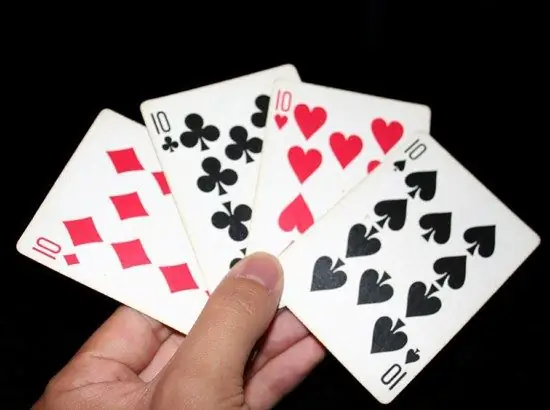To perform card tricks, you need to have an excellent memory, confidence in your actions and, of course, practical skills. Knowing how to manipulate cards with ease, you can amaze any viewer and feel yourself in the center of attention. Learning tricks is not so difficult as it might seem at first glance.

It is necessary
- - a deck of 36 cards;
- -a deck of 52 cards.
Instructions
Step 1
Trick "Four Aces" Prepare the deck in advance. Count eight cards from the top and place four aces under them. Now ask someone from the audience to name any number they like from 10 to 19, inclusive, and deal as many cards on the table as they tell you. For example, if you are given the number 13, you must deal the first 13 cards on the table. Then add those two numbers that make up your number (1 + 3 = 4) and take these 4 cards back to the deck. Lay the next (fifth) card separately without turning it over. Place the remaining cards on top of the deck. Repeat this procedure three more times for a total of 4 cards set aside. When you open them, everyone will see that there are four aces. For greater effect, let different people name the numbers.
Step 2
Handkerchief Swing Trick Take any two cards from the deck so that observers have the feeling that you only got one, and place them in the glass. Scatter the rest of the cards in a small pile aside. Cover the glass with a handkerchief and discreetly divide the cards, grabbing the first one seen by the audience. Holding the glass with your other hand, remove the handkerchief along with the card, and then discreetly drop it over the deck. If desired, you can demonstrate that the scarf is clean and there are no cards in it. Remember to practice ahead of time before showing trick to anyone.
Step 3
Trick "Which cards were taken" Divide the deck of cards into two parts. You should have cards in one pile, starting with aces and ending with tens, and all the rest in the second. Invite a spectator to pull out a few cards from the pile and memorize them. The other participant must do the same with the second pile. Ask the first participant to put their cards in the second pile and vice versa. Thus, it turns out that several large cards will be in a deck with small ones, and those, in turn, will be in a pile with large cards. Let each of the observers mix their part and return it to you. Now you can put on a pensive face and name the suits of each participant with confidence.






